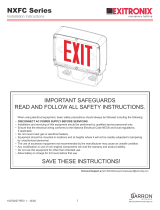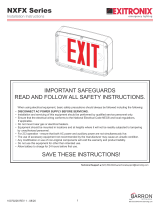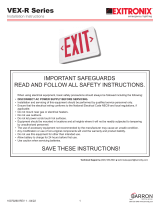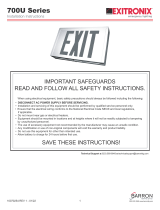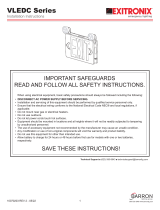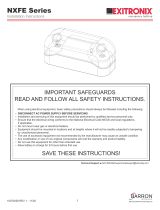Page is loading ...

IMPORTANT SAFEGUARDS
READ AND FOLLOW ALL SAFETY INSTRUCTIONS.
When using electrical equipment, basic safety precautions should always be followed including the following:
• DISCONNECT AC POWER SUPPLY BEFORE SERVICING.
• Installation and servicing of this equipment should be performed by qualified service personnel only.
• Ensure that the electrical wiring conforms to the National Electrical Code NEC® and local regulations,
if applicable.
• Do not mount near gas or electrical heaters.
• Do not use outdoors.
• Equipment should be mounted in locations and at heights where it will not be readily subjected to tampering
by unauthorized personnel.
• The use of accessory equipment not recommended by the manufacturer may cause an unsafe condition.
• Any modification or use of non-original components will void the warranty and product liability.
• Do not use this equipment for other than intended use.
• Allow battery to charge for 24 hours before first use.
SAVE THESE INSTRUCTIONS!
Technical Support ■ (623) 580-8943 ■ [email protected]
QMS Series
Installation Instructions
10070236 REV 1 - 01/21 1800-533-3948 www.barronltg.com

Wall/Ceiling Mount - Back Power Feed
1. Insert a flat screwdriver underneath both of the locking tabs on the
bottom of the fixture to loosen and separate the enclosure from
the backplate. (Fig. 1)
2. Punch out the center knockout and any desired knockouts for
mounting to the J-box located in the backplate.
3. Route wires out through the center hole of the backplate.
4. Make electrical connections; see Electrical Connections section.
5. Secure the backplate to the J-box using appropriate hardware
(provided by others).
6. Connect the battery to the PCB. (Fig. 2)
7. Snap the front cover back onto the backplate.
Wall/Ceiling Mount - Top Power Feed
1. Insert a flat screwdriver underneath both of the locking tabs on the
bottom of the fixture to loosen and separate the enclosure from
the backplate. (Fig. 1)
2. Punch out the conduit entry knockout from the top flange and any
desired knockouts for securing to the mounting surface located in
the backplate.
3. Secure the backplate to the mounting surface using appropriate hardware (provided
by others).
4. Secure flexible conduit (not provided) to the access hole and route wires through the
conduit to the J-box.
5. Make electrical connections; see Electrical Connections section.
6. Connect the battery to the PCB. (Fig. 2)
7. Punch out the conduit entry knockout from the top of the enclosure.
8. Snap the front cover back onto the backplate.
Fig. 1 Conduit Entry
Knockout
Backplate
Power
Connector
Locking Tabs
Fig. 2
Battery
Connector
Conduit Entry
Knockout
Use Flexible Conduit Only.
QMS Series
Installation Instructions
10070236 REV 1 - 01/21 2800-533-3948 www.barronltg.com

Electrical Connections
All electrical connections should be made inside the
J-box. Make electrical connection as follows:
120VAC 277VAC
White - Common White - Common
Black - 120VAC Orange - 277VAC
Green - Ground Green - Ground
Note: Cap unused leads to prevent shorting.
Remote Lamp Connection - 3.6V, 3W Max
(Option)
If the fixture is equipped with remote capability,
remove the jumper from the remote wire coming from
the PCB and replace it with the remote wire adapter
(included). All electrical connections should be made
inside the J-box. Make remote connections as
follows:
Yellow - Positive (+)
White - Negative (-)
LED
Indicator
Battery
PCB
Test
Button
Lamp
Red (277VAC)
Black (120VAC)
White (Com)
Backplate
Power
Connector
Lamp
Remote Connector
(If Equipped)
Yellow (+)
White (-)
Red (+)
Black (-)
QMS Series
Installation Instructions
10070236 REV 1 - 01/21 3 800-533-3948 www.barronltg.com

Self-Test/Self-Diagnostics (G2)
Operation
The purpose of this option is to provide Self-testing and Self-diagnostic capabilities to the emergency unit. At
predetermined intervals, the emergency unit will automatically switch into battery mode. Refer to the Self-Test Feature
section below for timing details. The emergency unit will also perform various Self-diagnostic tests to determine if there
are any faults. Visual signaling will alert maintenance personnel to a fault of the emergency unit electronics, battery,
and/or battery charger. The circuitry continuously monitors the operating condition of the emergency unit and battery
charging circuit/battery supply voltage. Refer to the LED Indicator section below for fault reporting details.
Self-Test Feature
• The emergency unit will automatically switch to battery mode every 30 days for a period of 30 seconds.
• The emergency unit will automatically switch to battery mode every 180 days for a period of 30 minutes.
• The emergency unit will automatically switch to battery mode every 365 days for a period of 90 minutes.
LED Indicator
Once the unit is properly installed according to the installation instruction sheet and AC power is supplied, the unit will turn
on and the Self-diagnostic test function will initiate. After this, the bi-color LED will indicate the status of the unit.
• A steady green LED indicates that normal AC power is being supplied to the emergency unit and the battery is
charged.
• A blinking green LED indicates that the unit is in battery mode. Refer to the Test Button Feature section below for
manual test details.
• A red/green flashing LED indicates that the battery is charging.
• A red LED indicates whenever the Self-diagnostic system has detected a fault condition. Refer to the chart below to
determine the fault condition:
Test Button Feature
MANUAL TEST – Pressing the test button will switch the unit into battery mode for a set amount of time. The desired
length of the test is determined by the number of times the test button is pressed.
• Pressing the test button once will switch the unit into battery mode for a period of 30 seconds. The LED indicator will
continuously blink green 1 time during this period.
• Pressing the test button twice within 2 seconds will switch the unit into battery mode for a period of 30 minutes. The
LED indicator will continuously blink green 2 time during this period.
• Pressing the test button 3 times within 2 seconds will switch the unit into battery mode for a period of 90 minutes. The
LED indicator will continuously blink green 3 time during this period.
RESET – Pressing and holding the test button for 3 seconds will cancel a test. Pressing and holding the test button for 6
seconds will reset the LED to a steady green. If multiple faults are present, it may be necessary to repeat this procedure
for each remaining fault indicated by the blinking red LED.
Use in accordance with local building codes.
Red LED Indication
Steady Red
Blinking 1 Time
Blinking 2 Times
Blinking 3 Times
Blinking 4 Times
Blinking 5 Times
Unit Fault
Battery is Disconnected
Electronics Failure
Battery Failure
N/A
Emergency Lamp
Remote Lamp (If Equipped)
Corrective Action
Check Battery Connection
Check Battery Then Consult Factory
Check Battery Then Consult Factory
N/A
Check Lamp Connections Then Consult Factory
Check Remote Lamp Connections Then Consult Factory
QMS Series
Installation Instructions
10070236 REV 1 - 01/21 4800-533-3948 www.barronltg.com
/

